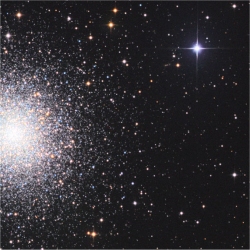
M13 by Cord Scholz
In 1938, television was still an experimental curiosity but three out of four homes owned a radio. This was a time when its power as a form of communication had yet to be fully recognized. That started to change on the evening of October 31 when a small cast of radio performers, lead by Orson Wells, convinced a lot of people that the United States was being invaded by creatures from somewhere other than our planet with his modern update of H.G. Well’s The War of the Worlds.
Almost seventy years ago, radio was exciting. People were still adjusting to its instantaneous connection with events from around the world as soon as they happened. Therefore, many listeners believed the dramatic presentation, presented as news during the radio play, was real. The broadcast has been followed by countless books, television shows and motion pictures which, combined, helped the notion of intelligent alien life to take firm roots in our culture. Science was also invaded by the possibility of extraterrestrial beings. In 1974, a carefully crafted message was transmitted from the world’s largest radio telescope and directed towards stars in M13, pictured here, in hopes someone or something would be listening.
M13 is one of the most prominent and best-known globular clusters in the night sky. It is the brightest that can be easily seen with a small telescope or pair of binoculars from most places in the northern hemisphere. Located in the constellation of Hercules, M13 is visible this time of year. It is twenty thousand lights years from Earth and its 100,000 stars form a ball so immense that it takes light 150 years to travel from one side to the other. The age of M13 is estimated at about 14 billion years.
The 1974 three minute message to M13 was beamed into space from the Arecibo Radio Telescope, in Puerto Rico, and was spearheaded by Dr. Frank Drake, a leading SETI proponent and colleague of the late Carl Sagan. A much longer three-hour message to other carefully selected stars was subsequently transmitted in 2001 from a radio telescope in the Ukraine. Of course, if anyone is around when our 1974 message arrives at a hypothetical planet orbiting a star in M13, their response will not return here until fifty thousand years have transpired.
This dazzling 1.2-hour exposure of M13 was produced by Cord Scholz from his imaging location in the northern German town of Hannover, which was also the birthplace of Wilhelm Herschel, the astronomer who discovered the planet Uranus. This image was taken with a 12.5 inch corrected newtonian telescope and an eleven mega-pixel camera. It also worth noting the number of far more distant galaxies that also fills this colorful picture.
Do you have photos you’d like to share? Post them to the Universe Today astrophotography forum or email them, and we might feature one in Universe Today.
Written by R. Jay GaBany
